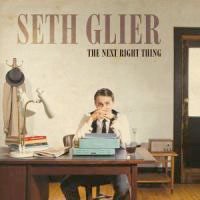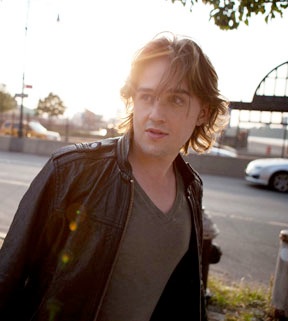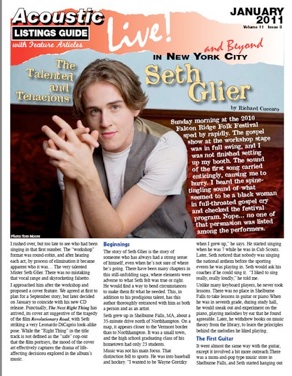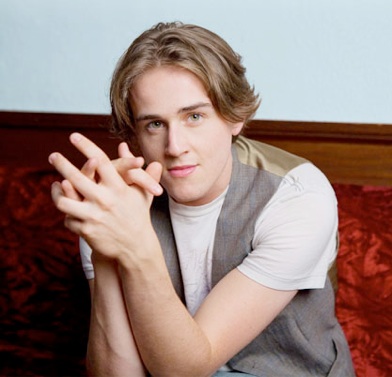The Talented and Tenacious
Seth Glier
by Richard Cuccaro
Sunday morning at the 2010 Falcon Ridge Folk Festival sped by rapidly. The gospel show at the workshop stage was in full swing, and I was not finished setting up my booth. The sound of the first song carried enticingly, causing me to hurry. I heard the spine-tingling sound of what seemed to be a black woman in full-throated gospel cry and checked the festival program. Nope… no one of that persuasion was listed among the performers.
I rushed over, but too late to see who had been singing in that first number. The “workshop” format was round-robin, and after hearing each act, by process of elimination it became apparent who it was… The very talented Mister Seth Glier. There was no mistaking that vocal range and skyrocketing falsetto.

Beginnings
The story of Seth Glier is the story of someone who has always had a strong sense of himself, even when he’s not sure of where he’s going. There have been many chapters in this still-unfolding saga, where elements were adverse to what Seth felt was true or right. He would find a way to bend circumstances to make them fit what he needed. This, in addition to his prodigious talent, has this author thoroughly entranced with him as both a person and as an artist.
Seth grew up in Shelburne Falls, MA, about a 35-minute drive north of Northhampton. On a map, it appears closer to the Vermont border than to Northhampton. It was a small town, and the high school graduating class of his hometown had only 23 students.
Music was not his main focus. That distinction fell to sports. He was into baseball and hockey. “I wanted to be Wayne Gretzky when I grew up,” he says. He started singing when he was 7 while he was in Cub Scouts. Later, Seth noticed that nobody was singing the national anthem before the sporting events he was playing in. Seth would ask his coaches if he could sing it. “I liked to sing really, really loudly,” he told me.
Unlike many keyboard players, he never took lessons. There was no place in Shelburne Falls to take lessons in guitar or piano.When he was in seventh grade, during study hall, he would sneak out and experiment on the piano, playing melodies by ear that he found agreeable. Later, he withdrew books on music theory from the library, to learn the principles behind the melodies he liked playing.
The First Guitar
It went almost the same way with the guitar, except it involved a bit more outreach.There was a mom-and-pop type music store in Shelburne Falls, and Seth started hanging out there somewhere around 15 years old. He’d do off-the-books “odd-and-ends” jobs for the owner, Bob, and plunk out melodies on a digital keyboard and on any guitar he could grab. Bob saw that music was in Seth’s blood and gave him a $60 Johnson guitar as partial payment for his services.
One harbinger of his destiny occurred when Noel “Paul” Stookey, of Peter, Paul and Mary fame stopped in the store (his wife taught nearby). Noel came into the room where Seth was already playing and began playing on another guitar. Noel and Seth jammed for a bit, and Seth, not realizing who he was, said, as Noel left, “Hey! You’re not bad, guy!” Recently, at a festival in Texas, he ran into Noel and recounted the story, but Noel had no recollection of it. Seth later played the mainstage right after Noel and Peter Yarrow.
The Songwriter Emerges
Seth sang in chorus from seventh grade until his sophomore year in high school. It was at the start of seventh grade that 9/11 occurred and it woke in Seth the desire to write — initially about his reaction to that tragic event. As he recalls: “I had been listening to Eminem, Linkin Park and Limp Bizkit on the back of the school bus. It wasn’t until after 9/11 that I started songwriting. I wrote my first song on that day. I started writing down words and learning the art of telling a story.” Suddenly he found himself dipping back in time to learn the nuts and bolts of some of the favorite music of his childhood, like Rosenchontz, a duo that sang children’s songs that he’d liked and found he still appreciated.
Through the years of public school music participation, Seth did some typical activities like musical plays and playing drums in the marching band. During his Sophomore year, he had stopped participating in organized musical programs and focused on his songwriting. When he insistently brought his guitar to school and wrote songs during study hall he was “asked to leave” (expelled). He finished high school at Pioneer Valley Performing Arts, a charter school for students wishing to apply artistic talents not catered to in public school. Seth felt like he’d found himself among kindred spirits — others who did not fit into the public school system. Later, he realized that he was far more serious about his music than most of the other students, many of whom saw the performing arts as a hobby. Seth knew he was going to be a performing songwriter — and nothing else (that changed later to include a more rounded view of life and purpose).
The Iron Horse
Pioneer Valley Performing Arts (PVPA)is located in South Hadley, MA, just south of Northampton and the prestigious performance venue, the Iron Horse. At age 16, Seth would get on the phone as soon as he got home from school and pester the booking person to allow him to play a headline show there. After a month-and-a-half, the booker acquiesced and Seth played a sold-out show filled with family and friends. He was given more gigs, but his numbers dwindled and he settled in as an opener. Shortly after, he took a job as a chef at the Iron Horse and got to serve and observe artists coming through. He’d confront them in the dressing room before the show as he served them the food he’d prepared, and introduce himself as a fellow performer, hoping to promote himself as an opener at their future gigs. Peter Mulvey was the most accommodating because they already knew each other. Seth had opened for Peter at a small gig when he was just 13. The day after his shows there, Peter and Seth would schedule a songwriting session together.

First Steps Toward the Road
Feeling his calling, Seth approached the principal at PVPA and asked to be allowed to create his own curriculum, geared toward life as a touring musician. The principal agreed and let Seth create his own course, satisfying Language Arts and History requirements. Seth hit the road running, right out of high school. He got himself a Toyota Camry with 250,000 miles on it and began performing around New England. He missed his high school graduation and prom because he was on tour with Ellis Paul. He’d cold-call people like Cheryl Wheeler, Shemekia Copeland, Cliff Eberhardt and Steve Forbert and ask for an opening slot. After it was cleared with the venue, he’d meet them there, before the show.
Berklee, Briefly
Seth was admitted to Berklee School of Music in Boston midway through his senior year of high school. It was the only school he applied to. He wanted to tour and play as soon as he got out of high school. If he didn’t get into Berklee, he intended to just keep performing. He auditioned for a scholarship and got it.
At Berklee, as a Songwriting major, Seth enlarged upon his already considerable skills, gaining more knowledge of musical structure, learning how to write musical scores. However, he reached a point where he felt that the courses in songwriting and vocalizing exercises were too rote — not at all practical, and he left after one year.
He watched other songwriters at the open mic every Tuesday night at Passim, the venerated Cambridge coffeehouse, and played a couple of times. He considered it a part of his education and has wondered aloud if Berklee shouldn’t be tapped into that community of singer/songwriters.
During his final months at Berklee, he audited a course with Livingston Taylor. This gave him greater insight into performance skills and holding the attention of an audience. Livingston perceived Seth’s innate ability and supported his decision to leave Berklee early and just start performing. He and Livingston have become good friends and Seth opens numerous shows for him throughout the year. Although Seth spent just one year there, he has since been interviewed by berkleegroove.com, “The Student Voice of Berklee College of Music,” as one its success stories and has been selected by Livingston to perform as part of a “Fresh Voices from Berklee College of Music” series (City Winery, NYC, Jan. 27th).
The Road Warrior

Seth signed a contract with MPRess Records and his first big tour after leaving Berklee was in support of his label debut, The Trouble with People. They toured in a Prius, were sponsored by Clif Bars and called it “The Zero Carbon Footprint Tour.” They also intended to create all of their merchandise out of organic cotton and print everything using soy and vegetable-based ink.
Part of Seth’s makeup and expansion of his worldview is in giving back. Part of the business of being a performer, he says, is in “showing up.” He and Ryan take time out to play hospitals and old-age facilities. Playing for free for the physically afflicted can have its own rewards. Sometimes, however, playing for critically ill children can be emotionally draining. It may be painful at times, but they keep showing up.
The Music
Seth released two independent CDs, Space (2005) and Sojourn (2007), and wrote the material for The Trouble with People (2009) while he was at Berklee. In November of 2008, I picked up an advance copy of The Trouble with People at the NERFA Conference, and wrote in the December issue CD reviews: “With a light, feather-like vocal delivery, sharp observational lyricism and hooks that would grab Moby Dick, he’s a formidable talent. In the title track, he sings, The trouble with people is they drive me nuts / Their feet on the gas and their hands on the clutch / Nobody knows how to take the wheel / It seems the mind has forgotten how the heart can feel. Amen, brother. In ‘Kiss & Kill,’ his voice begins in a barely audible whisper, then shows its power in a crescendo, Is this what you stay here for / to reassess the score? / The bitterness you held too long / Show me where did I go wrong? My eyes getting misty, he’s got me and I thank him for it.” I didn’t perceive until much later, the brilliant job he did in dissecting George W. Bush, in “I Just Want To Make My Daddy Proud.” I never planned to be a huckster / who sells this color-coded fear … Why are there all these angry people / I hear their ignorance so loud / I just want to make my daddy proud. He manages to emulate Randy Newman in a sympathetic presentation of someone most of us would consider to be odious.
On The Next Right Thing, Seth incorporates more strings, using the sonorous sounds of bowed cello or viola, in one intro section and in one outro section to accentuate a melancholy sense of human folly. In a very intelligent move, a pre-release download of “Lauralee” was made available on Seth’s website, presumably to both fans and DJs. WFUV’s John Platt aired it on his December 26th show. It’s an upbeat paean to a woman Seth can’t quite make it with, who he loves neverthless: Lauralee, you’re calling something out of me / When you set your stain in my fantasy, he sings. At the other end of the spectrum is “No Place To Land,” a lament for a colleague who’s lost his way: Now this shoebox of memories keeps me feeling alone / As I look to the skyway, now this highway is my home. The title track, inspired by a Michael J. Fox TV special, envisions a world of people who concern themselves with “doing the next right thing as opposed to the next thing right,” intoning gospel-like: Oh-Oh, you’re a long way from home, hear me sing / Oh-Oh, people need a miracle to do the next right thing. The new album is an important next step for Seth, on his way to building an impressive body of poetic work.
Jamie
A big part of Seth’s worldview can be traced to his relationship with Jamie, his older brother. Jamie is autistic and non-verbal and, additionally, has epilepsy. “Every morning (when I’m not on tour) I wake him up, get him showered, and give him breakfast. Each morning it grounds me and reminds me of why I’m here,” he says. Until Seth was 14-15, his role was as a protector and defender. Seth would stand up to other students who teased his brother. He’d get into fights and run afoul of school authorities as a result. That relationship expanded after they began to hang out and listen to music. Seth began listening to artists like Sarah Mclachlan, Sinead O’Connor and Taj Mahal, from his father’s eclectic record collection. In an online interview, he states: “…once I learned how to communicate with him, or with anyone, without words, it drastically changed my songwriting approach. It became more about what words to leave out, than what words I made sure I got in.” Seth sees the work of Randy Newman as an ideal. Randy’s ability to leave his ego behind, to see the world from the inside of another person, without judgement, regardless of that character’s imperfections is a paradigm. Seth’s connection with his brother hones that capacity in himself. After writing a song from another’s point of view, Seth finds that it winds up saying something important about himself.
Whatever Seth decides to say about himself or anyone else, we’d advise our readers to be there to hear it whenever possible. It’s not too late to get in on the ground floor as a witness to a great career. There’s a lot happening here and a lot more to come.
Website: sethglier.com
Upcoming appearances include:
Jan 4 7pm CD Release Party Nectars, Burlington, VT
5 6pm Apple Store Performance, Boylston Street, Boston, MA
6 8pm CD Release Party, Passim, Cambridge, MA
7 8pm CD Release Party, Tupelo Music Hall, Londonderry, NH
8 7pm CD Release Party, Iron Horse Music Hall, Northampton, MA
9 8pm WXPN 88.5 FM - Live Performance / Interview, Phila., PA
10 8pm CD Release Party, Brewer’s Alley, Frederick, MD
11 7pm The Living Room, WFUV’s “On Your Radar,” New York, NY
13 8pm CD Release Party, Tin Angel, Philadelphia, PA
14 5pm Best Buy @ Union Square, New York, NY
15 7:30pm CD Release Party, Rockwood Music Hall (STAGE 2),
New York, NY
21 6pm Best Buy - CD Signing & In Store Performance,
360 Newbury Street, Boston, MA
27 8pm City Winery, New York, NY


